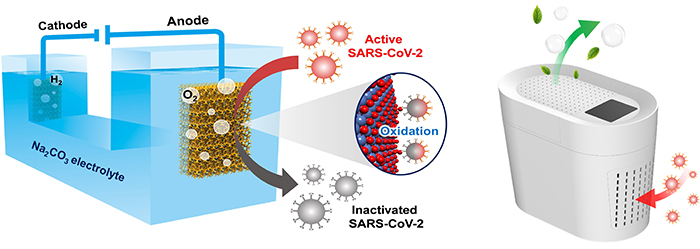At present, the pandemic coronavirus disease 2019 (COVID-19) has brought great challenges to the safety of human life.
Aerosols and wastewater containing the SARS-CoV-2 are produced in designated hospitals, isolation places and cold-chain logistics, which are highly infectious. Full disinfection of the aerosol and wastewater containing the SARS-CoV-2 is of key importance for blocking the spread of the virus.
Currently, sodium hypochlorite is the most popular disinfectant to kill the virus in the environment. Under the trend of normalization of epidemic prevention and control, the extensive use of chlorine containing disinfectants causes serious pollution to the ecological environment.
Recently, Prof. DENG Dehui's group and Prof. WANG Fangjun's group from the Dalian Institute of Chemical Physics (DICP) of the Chinese Academy of Sciences (CAS), in collaboration with Prof. HU Yangbo from the Wuhan Institute of Virology of the CAS, proposed a novel electrochemical oxidation strategy for inactivating the SARS-CoV-2 by using oxidative species generated on the anode in the water electrolysis, achieving full inactivation of the SARS-CoV-2 in the laboratory.
This study was published in Science Bulletin in Dec. 30.

Inactivating SARS-CoV-2 by electrochemical oxidation (Image by TU Yunchuan and YU Liang)
"We developed a green and highly-efficient electrochemical oxidation device and method to inactivate the SARS-CoV-2 based on the principle of redox reaction in water electrolysis, and conducted the inactivation experiments in the Wuhan Institute of Virology of the CAS," said Prof. DENG. The electrochemical device employed in-situ formed nickel oxide hydroxide (NiOOH) as anode, Ni foam as cathode and sodium carbonate as electrolyte.
The researchers treated the SARS-CoV-2 viruses in the solution for 5 minutes at a voltage of 5 volts with the electrochemical device, and it was found that viruses were inactivated with a high efficiency of 99.99%.
In-situ XAFS, liquid chromatography-mass spectrometry analysis combined with theoretical calculations indicated that the reactive oxygen species generated on the NiOOH anode could effectively oxidize and damage the receptor binding domain of the SARS-CoV-2 spike glycoprotein, and thereby fully inactivated the virus.
This green and efficient electrochemical inactivation strategy provides a new idea for blocking the potential transmission routes of the SARS-CoV-2, such as aerosols and sewage.
This work was supported by the National Natural Science Foundation of China, the Youth Innovation Promotion Association of CAS, and the innovation Project of DICP. (Text by TU Yunchuan and YU Liang)